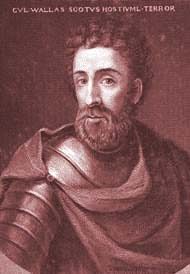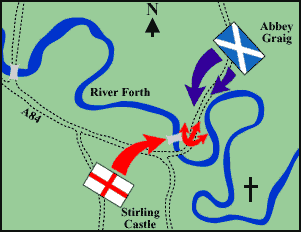  |
  |


Even before all the razzmatazz of "Braveheart" William Wallace was a national hero in Scotland, set on an equal footing with Robert the Bruce. Since the Mel Gibson film (based in part on the epic poem "Life of Wallace" by "Blind Harry" a 15th century minstrel) there has been an explosion of books on Wallace and many Web pages have been created on the Net.
The epic poem by Blind Harry recounts a number of incidents in Wallace's early life but it is his murder of the Sheriff of Lanark which was recorded in English records which launched Wallace onto the pages of history. A series of skirmishes followed, at various locations around Scotland from Aberdeenshire and Perth to Galloway and Ayrshire, recounted in the Blind Harry chronicle.
However Wallaces main claim to fame came from the Historic victory over his English Foes at the Battle of "Stirling Bridge"

In May 1297, an Andrew Murray, from the Black Isle, north of Inverness, raised the Standard of Scotland at Avoch Castle, igniting a revolt. Wallace and Murray joined forces in the fight against the occupying English. And had joint control of the Scottish Army at Stirling.
It is important to remember that neither Wallace or Murray were fighting to gain the throne of Scotland but in order to free the country from English domination.
At dawn the English and Welsh infantry start to cross the bridge only to be recalled due to the fact that their leader, Warenne, has overslept. Again they cross the bridge and again they are recalled: as Warenne believes the Scots might finally negotiate. Two Dominican friars are sent to Wallace to acquire his surrender and return shortly afterwards with William Wallace's first recorded speech:
'Tell your commander that we are not here to make peace but to do battle, defend ourselves and liberate our kingdom. Let them come on, and we shall prove this in their very beards.’
With the army swollen to 40,000 lightly armed foot soldiers and about 180 horses, the Scots took up the position on the steep sided high ground now known as Abbey Craig, looking across the Forth to Stirling and its vital castle. His men, who would have made the most of their own weapons, used 12ft long spears, axes and knives and wore rough hide tunics or homespun cloth; few would have had helmets or any form of body armour.
The English Governor of Scotland, John de Warenne, Earl of Surrey, commanded a force of mail-clad cavalry, skilled longbow men from Wales and well- weaponed infantry, in all numbering 60,000, with 8000 in reserve.
The flat ground beyond the bridge was marshy, and any attack would have to be made along a causeway and then uphill. From Abbey Craig, Wallace and Murray had a perfect view of the thin file of English fanning out from the bridge to pick their way hesitantly over the treacherous ground while their force lay in hiding at the foot of the Ochil Hills on their flank. It was the perfect situation for an ambush.
At the critical moment the Scots charged down the slopes to reach the bridgehead and trap a manageable number of the enemy who perished in their thousands, caught between the Scottish spears and the river. What cavalry had crossed the bridge was soon floundering in the boggy ground, and those fighting to get back over it were blocked by those still advancing. Only one, Sir Marmaduke de Twenge, succeeded; he spurred his horse through the press at the bridge, no doubt killing and injuring many of them.
Most of the men who had crossed were killed by the Scots, who must have been shaking their heads at the incredible folly of the English leaders. The English baggage train was captured, with a host of valuable supplies.
After the Battle of Stirling Bridge, William Wallace was knighted and put in sole command of the Scottish troops.
Unfortunately on the Scots side, Andrew Murray is fatally wounded. He dies two months later from his wounds and is buried at Fortrose Cathedral on Black Isle, north of Inverness.
The golden glow of success for Wallace, was not destined to shine long, however. Edward I was a leader not likely to make the same mistakes as the Earl of Surrey, and he led a sizeable army north to deal with Wallace himself. They met at the Battle of Falkirk just 10 months later. Where the Scots faced a heavy defeat, resulting in the end of Wallaces bid to gain freedom.
William Wallace was certainly a brave freedom fighter who inspired his men and he won many fights against the English. However in full frontal Battles with his foes, He had one victory and won loss. Many believe that the victory at Stirling Bridge was down to Andrew Murray deciding the tactics and commanding the Troops.
Sadly dead men do not always make great heroes. Andrew Murray`s name has slowly faded in obscurity in Scottish history, While Wallace became the BRAVEHEART of legends.
| © RIYAN Productions |